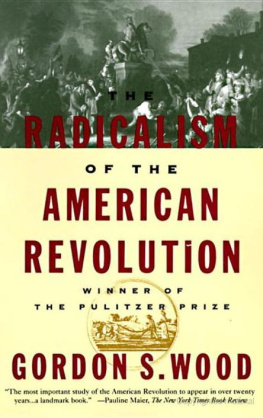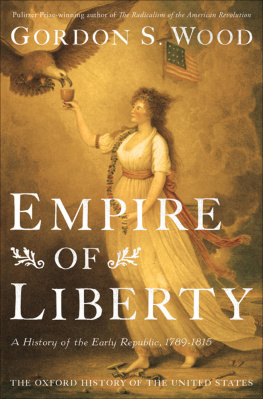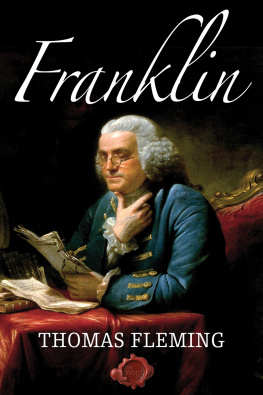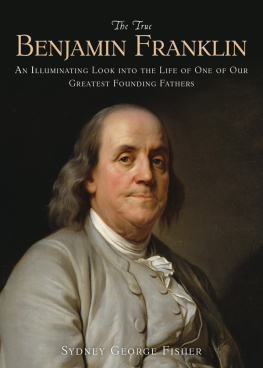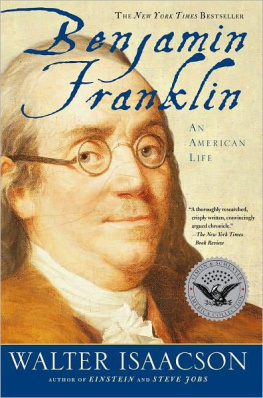THE PENGUIN PRESS
a member of
Penguin Group (USA) Inc.
Hudson Street
New York, New York 10014
Copyright Gordon Wood,
All rights reserved
Illustration credits appear on pp. 285-86.
Library of Congress Cataloging-in-Publication Data
Wood, Gordon S.
The Americanization of Benjamin Franklin / Gordon S. Wood.
p. cm.
Includes bibliographical references (p. ) and index.
ISBN: 978-1-1012-0090-2
DESIGNED BY MARYSARAH QUINN
Without limiting the rights under copyright reserved above, no part of this publication may be reproduced, stored in or introduced into a retrieval system, or transmitted, in any form or by any means (electronic, mechanical, photocopying, recording, or otherwise), without the prior written permission of both the copyright owner and the above publisher of this book.
The scanning, uploading, and distribution of this book via the Internet or via any other means without the permission of the publisher is illegal and punishable by law. Please purchase only authorized electronic editions and do not participate in or encourage electronic piracy of copyrighted materials. Your support of the authors rights is appreciated.
First edition (electronic): February 2003
Making or distributing electronic copies of this book constitutes copyright infringement and could subject the infringer to criminal and civil liability.
THE PENGUIN PRESS
a member of
Penguin Group (USA) Inc.
Hudson Street
New York, New York 10014
Copyright Gordon Wood,
All rights reserved
Illustration credits appear on pp. 285-86.
Library of Congress Cataloging-in-Publication Data
Wood, Gordon S.
The Americanization of Benjamin Franklin / Gordon S. Wood.
p. cm.
Includes bibliographical references (p. ) and index.
MSR ISBN 0-7865-4787-1
AEB ISBN 0-7865-4788-X
DESIGNED BY MARYSARAH QUINN
Without limiting the rights under copyright reserved above, no part of this publication may be reproduced, stored in or introduced into a retrieval system, or transmitted, in any form or by any means (electronic, mechanical, photocopying, recording, or otherwise), without the prior written permission of both the copyright owner and the above publisher of this book.
The scanning, uploading, and distribution of this book via the Internet or via any other means without the permission of the publisher is illegal and punishable by law. Please purchase only authorized electronic editions and do not participate in or encourage electronic piracy of copyrighted materials. Your support of the authors rights is appreciated.
First edition (electronic): February 2003
Making or distributing electronic copies of this book constitutes copyright infringement and could subject the infringer to criminal and civil liability.
ALSO BY GORDON S. WOOD
The Creation of the American Republic, 17761787
The Radicalism of the American Revolution
The American Revolution: A History
TO CHRISTOPHER, ELIZABETH, AND AMY
O F MAKING MANY BOOKS there is no end, and with the upcoming tricentennial celebration of Benjamin Franklins birth in 2006, this seems to be especially true of Franklin biographies. But this book is not meant to be a traditional biography of Franklin. It does not contain every event in his long life, nor does it deal with all of his multitudinous relationships and writings. Instead, it is a relatively selective study, focusing on specific aspects of this extraordinary mans life that reveal a Benjamin Franklin who is different in important ways from the Franklin of our inherited common understanding.
First of all, the book attempts to penetrate beneath the many images and representations of Franklin that have accumulated over the past two hundred years and recover the historic Franklin who did not know the kind of massively symbolic folk hero he would become. At the same time it hopes to make clear how and why Franklin acquired these various images and symbols. It tries to place Franklins incredible life in its eighteenth-century context and explain why he retired from business and became a gentleman, why he came to admire the British Empire and sought to become its architect, why he began writing his Autobiography when he did, and why he belatedly joined the American Revolution, and joined it with a vengeance. It seeks to clarify the personal meaning the Revolution had for him and to describe his extraordinary achievements as Americas envoy to Franceachievements that were never fully appreciated by many of his countrymen at the time. It attempts also to account for the way in which the French came to see Franklin as the symbol of America even before his fellow Americans did. Indeed, without understanding Franklins intimate connection with France we will never make sense of the remarkable degree of hostility Franklin faced in the last years of his life from members of Congress and other influential Americans. Even after his death in 1790 the hostility continued, especially as Franklin emerged as the representative American, as the hardworking self-made businessman, for hundreds of thousands of middling Americans in the early decades of the nineteenth century.
This early-nineteenth-century image of Franklin was not the image of Franklin known to people in his own lifetime; it was a product of the turbulent capitalism of the age of Jackson, the age so brilliantly depicted by Alexis de Tocqueville in his Democracy in America. And it is that popular image that seems to have the most resonance even today. Despite the continuing power of Franklins symbolic significance as the entrepreneurial American, however, the historic Franklin of the eighteenth century was never destined to be that symbol. Franklin was not even destined to be an American. How he became one is the theme of this book.
T HIS BOOK HAS BEEN in my mind for many years. I first became interested in writing about Franklin when I reviewed several volumes of his papers in the early 1970s. I let my thoughts about this extraordinary character stew for a decade. Then in 1983 the late William B. Cohen, chair of the Department of History of Indiana University, invited me to present a lecture on Franklin as part of Indiana Universitys bicentennial celebration of the signing of the Treaty of Paris, which ended the Revolutionary War against Britain. This invitation forced me to put some of my thoughts about Franklin on paper. So I am grateful to Professor Cohen and Indiana University for the invitation that got me started on this book. Franklin next became an important figure in my book The Radicalism of the American Revolution, and the several paragraphs devoted to him there anticipate some of what is in this study. Indeed, what happened to Franklin and Franklins image between the middle of the eighteenth century and the early decades of the nineteenth century seems to me to demonstrate vividly the radical social and cultural changes that the American Revolution brought about.
Much of the book was written when I was a fellow at the Institute for United States Studies in London in the winter and spring of 2002, and I want to thank the institute and its staff for their hospitality. For their editorial expertise I am grateful to my wife, Louise, and my daughter Elizabeth, and my friends Lesley Herrmann and Barbara Oberg. I am especially indebted to Ellen Cohn, who is currently the editor in chief of the Franklin Papers, not only for her careful reading of the manuscript, which saved me from many errors, but also for her making available to me a CD-ROM of the Franklin Papers, which includes those papers not yet published in the magnificent letterpress edition of Yale University Press. I am grateful too to my agent, Andrew Wylie, for all his support. My thanks also to Sophie Fels at The Penguin Press for her considerable and always cheerful aid in preparing the manuscript. My final thanks go to my editor at The Penguin Press, Scott Moyers, who is every authors dream of what an editor ought to be. He could not have been more helpful, and I am very grateful to him.


